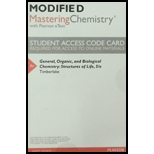
(a)
Interpretation:
In the following table, indicate the number of protons, neutrons, and electrons for each isotope listed:
| Isotope | Number of Protons | Number of Neutrons | Number of Electrons |
Concept Introduction:
(b)
Interpretation:
To writethe electron configuration and the abbreviated electron configuration of Si Concept Introduction:The electron configuration is the distribution of electrons of an element in different orbits and orbitals.
(c)
Interpretation:
To calculate the
Concept Introduction:
(d)
Interpretation:
To write the balanced
Concept Introduction:A positron is a positively charged electron wherein the new element formed has the same mass number as the parent element but has -1 decreased atomic number.
Beta decay is the loss of an electron wherein the new element formed has the same mass number as the parent element but has +1 increased atomic number.
(e)
Interpretation:
Todraw the Lewis structure and predict the shape of SiCl4
Concept Introduction:Lewis structure shows the covalent bonds between atoms in a molecule. It also shows the lone pair of electrons on the element in the compound.
(f)
Interpretation:
To find how many hours are needed for a sample of Si-31 with an activity of 16µCi to decay to 2.0µ Ci
Concept Introduction:Radioactive decay equation:
where No is the initial activity, N(t) is the activity at time t, and t1/2is the half life of the radioactive substance.
Want to see the full answer?
Check out a sample textbook solution
Chapter 16 Solutions
Modified MasteringChemistry with Pearson eText - Valuepack Access Card - for General, Organic, and Biological Chemistry: Structures of Life
 ChemistryChemistryISBN:9781305957404Author:Steven S. Zumdahl, Susan A. Zumdahl, Donald J. DeCostePublisher:Cengage Learning
ChemistryChemistryISBN:9781305957404Author:Steven S. Zumdahl, Susan A. Zumdahl, Donald J. DeCostePublisher:Cengage Learning ChemistryChemistryISBN:9781259911156Author:Raymond Chang Dr., Jason Overby ProfessorPublisher:McGraw-Hill Education
ChemistryChemistryISBN:9781259911156Author:Raymond Chang Dr., Jason Overby ProfessorPublisher:McGraw-Hill Education Principles of Instrumental AnalysisChemistryISBN:9781305577213Author:Douglas A. Skoog, F. James Holler, Stanley R. CrouchPublisher:Cengage Learning
Principles of Instrumental AnalysisChemistryISBN:9781305577213Author:Douglas A. Skoog, F. James Holler, Stanley R. CrouchPublisher:Cengage Learning Organic ChemistryChemistryISBN:9780078021558Author:Janice Gorzynski Smith Dr.Publisher:McGraw-Hill Education
Organic ChemistryChemistryISBN:9780078021558Author:Janice Gorzynski Smith Dr.Publisher:McGraw-Hill Education Chemistry: Principles and ReactionsChemistryISBN:9781305079373Author:William L. Masterton, Cecile N. HurleyPublisher:Cengage Learning
Chemistry: Principles and ReactionsChemistryISBN:9781305079373Author:William L. Masterton, Cecile N. HurleyPublisher:Cengage Learning Elementary Principles of Chemical Processes, Bind...ChemistryISBN:9781118431221Author:Richard M. Felder, Ronald W. Rousseau, Lisa G. BullardPublisher:WILEY
Elementary Principles of Chemical Processes, Bind...ChemistryISBN:9781118431221Author:Richard M. Felder, Ronald W. Rousseau, Lisa G. BullardPublisher:WILEY





